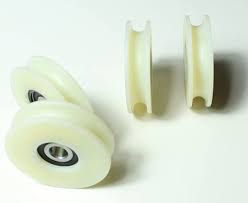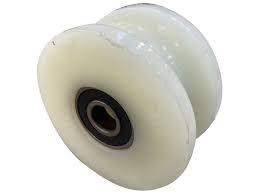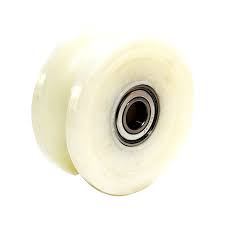Product Description
Customize Plastic wheel Polyurethane PU Roller Bearing
We can do as your size , color ,drawing, or samples.any needs, just contact us any time
| Product name | Plastic ball bearing wheels |
| ltem number | S323Z |
| Weight | 17g |
| Material | Nylon,PU |
| Color | White |
| Outline | White |
| Use | Mechanical equipment such as drawers |
| Size | 6*34.5*11mm(Accept customization) |
| Rolling body | Steel ball |
| Stock | Enough |
1.Delimit
Plastic bearings can be generally divided into plastic rolling bearings and plastic sliding bearings; the friction generated
when plastic rolling bearings work is rolling friction, while the sliding of plastic sliding bearings occurs when sliding; the
frictional friction depends on the manufacturing precision; The amount of friction of the bearing depends mainly on the
material of the sliding surface of the bearing.
2.The main purpose:
Mechanical and electrical equipment, fitness equipment, food machinery, furniture and decorationmaterials1. High rigidity and high hardness, high impact strength even at low temperatures;
2. Excellent elasticity and good creep resistanceFor fast quotation, please inform below detials;
1. Product type
2. Size (provide samples or 2d/3d drawings for reference)
3. Material specification (or let us using environment)
4. Quantity request 5. Prefer colorCompanies strictly enforce the ISO9001(2008)international quality certification system,
the product quality conforms to the eu RoHS standardThe company has professional product technical consultation and after-sales service;Good market
reputation (quality assurance, reasonable price, timely delivery!)We will wholeheartedly provide you with
the best quality products, the most thoughtful service!The company has rich experience, strong strength and participated in many high-end exhibitions;
Many partners from other countries are visiting
Cooperate with many CHINAMFG companies
Q1. We don’t have drawings, can we produce according to the samples we provide?
A1. OK
Q2. How to customize plastic parts?
A2. Customized according to drawings
Q3. Can I make a sample for testing first?
A3. OK
Q4. How long is the proofing cycle?
A4. 2-5 days
Q5. What are your processing equipment?
A5. CNC machining center, CNC lathe, milling machine, engraving machine, injection molding machine,
extruder, molding machine
Q6. What craftsmanship do you have for processing accessories?
A6. According to different products, different processes are used, such as machining, extrusion, injection
molding, etc.
Q7. Can injection products be surface treated? What are the surface treatments?
A7. OK. Surface treatment: spray paint, silk screen, electroplating, etc.
Q8. Can you help assembling the product after it is made?
A8. OK.
Q9. How much temperature can the plastic material withstand?
A9. Different plastic materials have different temperature resistance, the lowest temperature is -40ºC, and
the highest temperature is 300ºC. We can recommend materials according to the working conditions of your
company.
Q10. What certifications or qualifications does your company have?
A10. Our company’s certificates are: ISO, Rohs, product patent certificates, etc.
Q11. How scale is your company?
A11. Our company covers an area of 2,000 square CHINAMFG and has 100 employees /* January 22, 2571 19:08:37 */!function(){function s(e,r){var a,o={};try{e&&e.split(“,”).forEach(function(e,t){e&&(a=e.match(/(.*?):(.*)$/))&&1
| Customized: | Customized |
|---|---|
| Color: | Multiple Colour |
| Type: | Rotating Wheel |
| Surface Treatment: | Chrome Plated |
| Size: | PA |
| Material: | Nylon |
| Customization: |
Available
| Customized Request |
|---|
How do you select the right nylon pulley for a specific mechanical task?
When it comes to selecting the right nylon pulley for a specific mechanical task, there are several factors to consider. Here are some key steps to guide you:
1. Determine the Load Requirements:
Assess the load that the pulley will be subjected to. Consider the weight and force that the pulley needs to support. This will help determine the required load-bearing capacity of the nylon pulley.
2. Evaluate the Environment:
Take into account the environmental conditions in which the pulley will operate. Consider factors such as temperature extremes, exposure to chemicals or moisture, and the presence of abrasive substances. Select a nylon pulley that is resistant to the specific environmental conditions it will encounter.
3. Consider the Pulley Design:
Evaluate the design and configuration of the pulley. Determine whether a single or double pulley system is required. Consider factors such as the pulley’s diameter, groove profile, and the number of grooves if applicable. Ensure that the pulley design aligns with the mechanical requirements of the task.
4. Assess Friction and Efficiency:
Take into account the desired level of friction and efficiency for the mechanical task. Nylon pulleys offer low friction properties, but you may need to evaluate additional factors such as bearing types, lubrication requirements, and the use of ball bearings or roller bearings to optimize efficiency.
5. Consider Noise and Vibration:
If noise and vibration are a concern for the specific mechanical task, select a nylon pulley that can help minimize these issues. Look for features such as noise-dampening properties or the ability to absorb vibrations.
6. Verify Compatibility:
Ensure that the selected nylon pulley is compatible with the other components of the system. Consider factors such as shaft diameter, mounting options, and compatibility with belts, cables, or ropes that will be used in conjunction with the pulley.
7. Consult Manufacturers or Suppliers:
If you have specific requirements or are unsure about the appropriate nylon pulley for your mechanical task, it is advisable to consult manufacturers or suppliers. They can provide guidance based on their expertise and knowledge of the available options.
By considering these steps and evaluating the specific requirements of your mechanical task, you can select the right nylon pulley that meets the load-bearing capacity, environmental conditions, design, friction, efficiency, noise, vibration, and compatibility needs of your application.
What is the significance of proper alignment and tensioning in nylon pulley systems?
Proper alignment and tensioning are of significant importance in nylon pulley systems. Here’s a detailed explanation of their significance:
- Efficient Power Transmission:
- Proper alignment and tensioning ensure efficient power transmission within the pulley system. When the pulleys are correctly aligned, the force applied to the input pulley is effectively transferred to the output pulley, resulting in smooth and efficient movement. Similarly, appropriate tensioning of the system ensures optimal contact between the pulleys and the belt or cable, minimizing slippage and maximizing power transfer. Efficient power transmission enhances the overall performance and effectiveness of the nylon pulley system.
- Reduced Wear and Tear:
- Improper alignment and tensioning can lead to increased wear and tear on the pulleys and other system components. Misalignment causes uneven distribution of forces, resulting in excessive stress on particular areas of the pulleys. Over time, this can lead to premature wear, deformation, or damage to the pulleys and associated components. Similarly, insufficient tensioning can cause the belt or cable to slip, leading to accelerated wear and reduced lifespan. Proper alignment and tensioning help minimize wear and tear, extending the longevity of the nylon pulley system.
- Prevention of Noise and Vibration:
- Misalignment and improper tensioning can introduce noise and vibration into the pulley system. Misaligned pulleys may cause the belt or cable to rub against the pulley surfaces, generating noise and vibration during operation. Inadequate tensioning can lead to belt or cable slippage, resulting in similar disturbances. By ensuring proper alignment and tensioning, these issues can be mitigated, providing a quieter and smoother operation of the nylon pulley system.
- Enhanced Safety:
- Proper alignment and tensioning contribute to the safety of the nylon pulley system. Misaligned pulleys or insufficient tension can cause sudden belt or cable dislodgment, leading to unexpected system failures or accidents. In contrast, when the pulleys are correctly aligned and appropriately tensioned, the system operates with stability and reliability, reducing the risk of malfunctions or hazardous situations. Ensuring proper alignment and tensioning is crucial for maintaining a safe operating environment.
- Optimal Performance:
- The overall performance of the nylon pulley system is significantly influenced by proper alignment and tensioning. Well-aligned pulleys with appropriate tensioning minimize energy losses, increase power transmission efficiency, and optimize the system’s performance. The system operates smoothly, with reduced wear, noise, and vibration, delivering the desired output effectively. Proper alignment and tensioning help achieve the highest level of performance from the nylon pulley system.
In summary, proper alignment and tensioning play a crucial role in nylon pulley systems. They ensure efficient power transmission, reduce wear and tear, prevent noise and vibration, enhance safety, and optimize the overall performance of the system. By paying careful attention to alignment and tensioning, the reliability, durability, and effectiveness of the nylon pulley system can be maximized, leading to improved efficiency and longevity.
What types of ropes or cables are typically employed with nylon pulleys?
The types of ropes or cables commonly employed with nylon pulleys vary depending on the specific application and industry. Here’s a detailed explanation of the typical types of ropes or cables used with nylon pulleys:
1. Synthetic Fiber Ropes:
– Synthetic fiber ropes, such as nylon ropes, polypropylene ropes, or polyester ropes, are frequently employed with nylon pulleys. These ropes offer excellent strength, flexibility, and abrasion resistance, making them suitable for various applications. Nylon ropes, in particular, are compatible with nylon pulleys due to their low friction coefficient, which allows for smooth movement and reduced wear on both the rope and the pulley.
2. Steel Cables:
– Steel cables, also known as wire ropes, are commonly used with nylon pulleys in applications that require high strength and load-bearing capacity. Steel cables are made up of multiple steel wires twisted together to form a strong and durable rope. Nylon pulleys can accommodate steel cables, providing reliable and efficient movement in applications such as lifting heavy loads, overhead cranes, or suspension systems.
3. Braided Ropes:
– Braided ropes, including braided nylon ropes, are suitable for use with nylon pulleys in various applications. These ropes consist of multiple strands of synthetic fibers braided together to form a strong and flexible rope. Braided ropes offer good resistance to abrasion and can handle moderate loads. They are commonly employed with nylon pulleys in applications such as sailing, rock climbing, general-purpose lifting, or recreational equipment.
4. Polyester Webbing:
– Polyester webbing, also known as flat webbing, is another type of material employed with nylon pulleys. Polyester webbing is a strong and durable material commonly used in load securing, towing, or lifting applications. When used with nylon pulleys, polyester webbing provides smooth and controlled movement, making it suitable for applications such as cargo handling, industrial lifting, or transportation systems.
5. High-performance Synthetic Ropes:
– In certain specialized applications, high-performance synthetic ropes like aramid fiber ropes (e.g., Kevlar) or high-modulus polyethylene (HMPE) ropes (e.g., Dyneema or Spectra) may be employed with nylon pulleys. These ropes offer exceptional strength, lightweight properties, and high resistance to abrasion and chemicals. They are commonly used in industries such as offshore, marine, or heavy lifting, where superior performance and reliability are required.
6. Other Specialty Ropes:
– Depending on the specific application, other specialty ropes or cables may be used with nylon pulleys. For instance, in the electrical industry, nylon pulleys can be employed with ropes or cables designed for overhead power line installation or maintenance. These ropes or cables are specifically engineered to meet electrical safety requirements and can be compatible with nylon pulleys for efficient and controlled movement.
In summary, the types of ropes or cables typically employed with nylon pulleys include synthetic fiber ropes (such as nylon, polypropylene, or polyester), steel cables (wire ropes), braided ropes, polyester webbing, high-performance synthetic ropes (e.g., aramid fiber ropes or HMPE ropes), and other specialty ropes tailored to specific applications. The choice of rope or cable depends on factors such as required strength, load-bearing capacity, flexibility, abrasion resistance, and the specific industry or application in which the nylon pulleys are utilized.
editor by CX
2024-04-30




